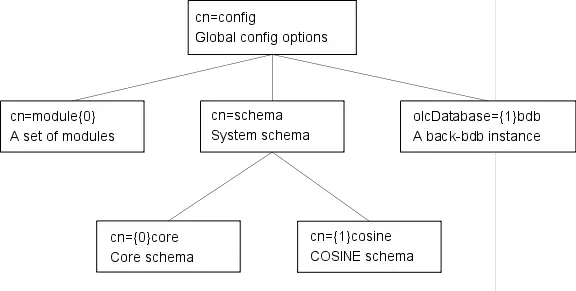The slapd configuration is stored as a special LDAP directory with a predefined schema and DIT. There are specific objectClasses used to carry global configuration options, schema definitions, backend and database definitions, and assorted other items. A sample config tree is shown in Figure 5.1.

Figure 5.1: Sample configuration tree.
Other objects may be part of the configuration but were omitted from the illustration for clarity.
The slapd-config configuration tree has a very specific structure. The root of the tree is named cn=config and contains global configuration settings. Additional settings are contained in separate child entries:
- Dynamically loaded modules
These may only be used if the --enable-modules option was used to configure the software.
- Schema definitions
The cn=schema,cn=config entry contains the system schema (all the schema that is hard-coded in slapd).
Child entries of cn=schema,cn=config contain user schema as loaded from config files or added at runtime.
- Backend-specific configuration
- Database-specific configuration
Overlays are defined in children of the Database entry.
Databases and Overlays may also have other miscellaneous children.
The usual rules for LDIF files apply to the configuration information: Comment lines beginning with a '#' character are ignored. If a line begins with a single space, it is considered a continuation of the previous line (even if the previous line is a comment) and the single leading space is removed. Entries are separated by blank lines.
The general layout of the config LDIF is as follows:
# global configuration settings
dn: cn=config
objectClass: olcGlobal
cn: config
<global config settings>
# schema definitions
dn: cn=schema,cn=config
objectClass: olcSchemaConfig
cn: schema
<system schema>
dn: cn={X}core,cn=schema,cn=config
objectClass: olcSchemaConfig
cn: {X}core
<core schema>
# additional user-specified schema
...
# backend definitions
dn: olcBackend=<typeA>,cn=config
objectClass: olcBackendConfig
olcBackend: <typeA>
<backend-specific settings>
# database definitions
dn: olcDatabase={X}<typeA>,cn=config
objectClass: olcDatabaseConfig
olcDatabase: {X}<typeA>
<database-specific settings>
# subsequent definitions and settings
...
Some of the entries listed above have a numeric index "{X}" in their names. While most configuration settings have an inherent ordering dependency (i.e., one setting must take effect before a subsequent one may be set), LDAP databases are inherently unordered. The numeric index is used to enforce a consistent ordering in the configuration database, so that all ordering dependencies are preserved. In most cases the index does not have to be provided; it will be automatically generated based on the order in which entries are created.
Configuration directives are specified as values of individual attributes. Most of the attributes and objectClasses used in the slapd configuration have a prefix of "olc" (OpenLDAP Configuration) in their names. Generally there is a one-to-one correspondence between the attributes and the old-style slapd.conf configuration keywords, using the keyword as the attribute name, with the "olc" prefix attached.
A configuration directive may take arguments. If so, the arguments are separated by white space. If an argument contains white space, the argument should be enclosed in double quotes "like this". In the descriptions that follow, arguments that should be replaced by actual text are shown in brackets <>.
The distribution contains an example configuration file that will be installed in the /usr/local/etc/openldap directory. A number of files containing schema definitions (attribute types and object classes) are also provided in the /usr/local/etc/openldap/schema directory.
